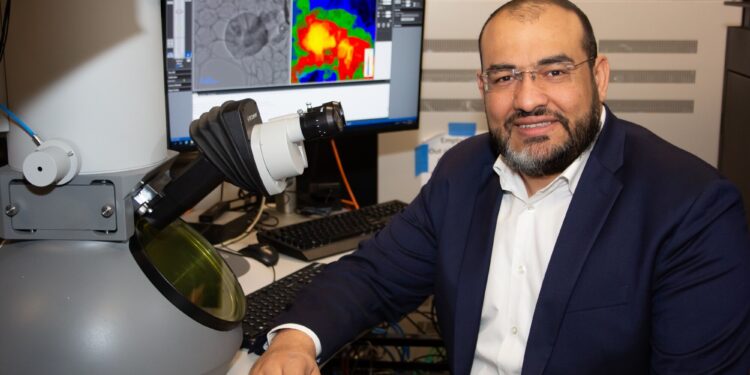Mohammed Hassan, associate professor of physics and optical sciences, helped a group of researchers develop the first transmission electron microscope powerful enough to capture images of moving electrons. Credit: Amee Hennig
Imagine having a camera so powerful it could take still photos of a moving electron, an object that moves so fast it could circle the Earth several times in a second. Researchers at the University of Arizona have developed the world’s fastest electron microscope that can do just that.
They believe their work will lead to revolutionary advances in physics, chemistry, bioengineering, materials science and much more.
“When you get the latest version of a smartphone, it comes with a better camera,” said Mohammed Hassan, associate professor of physics and optical sciences.
“This transmission electron microscope is like a very powerful camera that is equipped in the latest smartphones. It allows us to take pictures of things that we could not see before, such as electrons. With this microscope, we hope that the scientific community will be able to understand the quantum physics underlying the behavior and movements of an electron.”
Hassan led a team of researchers from the departments of physics and optical sciences who published the research paper “Attosecond electron microscopy and diffraction” in the Scientific progress newspaper.
Hassan worked alongside Nikolay Golubev, assistant professor of physics; Dandan Hui, co-senior author and former research associate in optics and physics who now works at the Institute of Optics and Precision Mechanics in Xi’an, Chinese Academy of Sciences; Husain Alqattan, co-senior author, University of Alberta alumnus and assistant professor of physics at Kuwait University; and Mohamed Sennary, a graduate student in optics and physics.
A transmission electron microscope is a tool used by scientists and researchers to magnify objects up to millions of times their actual size in order to see details too small to be detected by a traditional optical microscope.
Instead of using visible light, a transmission electron microscope directs beams of electrons through the sample being studied. The interaction between the electrons and the sample is captured by lenses and detected by a camera sensor to generate detailed images of the sample.
Ultrafast electron microscopes using these principles were first developed in the 2000s and use a laser to generate pulsed electron beams. This technique greatly increases the temporal resolution of a microscope, that is, its ability to measure and observe changes in a sample over time.
In these ultrafast microscopes, instead of relying on the shutter speed of a camera to determine image quality, the resolution of a transmission electron microscope is determined by the duration of the electron pulses.
The faster the pulse, the better the image.
Ultrafast electron microscopes previously worked by emitting a series of electron pulses at a rate of a few attoseconds. An attosecond is one quintillionth of a second. Pulses at these speeds create a series of images, like frames in a movie. But scientists still couldn’t identify the reactions and changes that occur in an electron between these frames as it moves in real time.
To see an electron frozen in place, researchers at the University of Alberta have, for the first time, generated a single, one-attosecond electron pulse, which is as fast as the electrons move, improving the microscope’s temporal resolution, like a high-speed camera capturing movements that would otherwise be invisible.
Hassan and his colleagues based their work on the Nobel Prize-winning achievements of Pierre Agostini, Ferenc Krausz and Anne L’Huilliere, who won the Nobel Prize in Physics in 2023 after generating the first pulse of extreme ultraviolet radiation so short it could be measured in attoseconds.
Building on this work, researchers at the University of Alberta have developed a microscope in which a powerful laser is split and converted into two parts: a very fast electron pulse and two ultra-short light pulses. The first light pulse, called a pump pulse, energizes a sample and causes electrons to move or make other rapid changes.
The second light pulse, also called the “optical trigger pulse,” acts as a gate, creating a brief time window during which the single, one-attosecond electron pulse is generated. The speed of the trigger pulse therefore determines the resolution of the image. By carefully synchronizing the two pulses, the researchers control when the electron pulses probe the sample to observe ultrafast processes at the atomic level.
“Improving the temporal resolution inside electron microscopes is long overdue and the focus of many research groups because we all want to see the movement of electrons,” Hassan said.
“These movements occur in attoseconds. But now, for the first time, we are able to achieve attosecond time resolution using our transmission electron microscope, which we call ‘attomicroscopy’. For the first time, we can see pieces of electrons in motion.”
More information:
Dandan Hui et al, Attosecond electron microscopy and diffraction, Scientific progress (2024). DOI: 10.1126/sciadv.adp5805. www.science.org/doi/10.1126/sciadv.adp5805
Provided by the University of Arizona
Quote: Freeze Frame: Researchers Develop World’s Fastest Microscope That Can See Moving Electrons (2024, August 21) retrieved August 22, 2024 from
This document is subject to copyright. Apart from any fair dealing for the purpose of private study or research, no part may be reproduced without written permission. The content is provided for informational purposes only.



